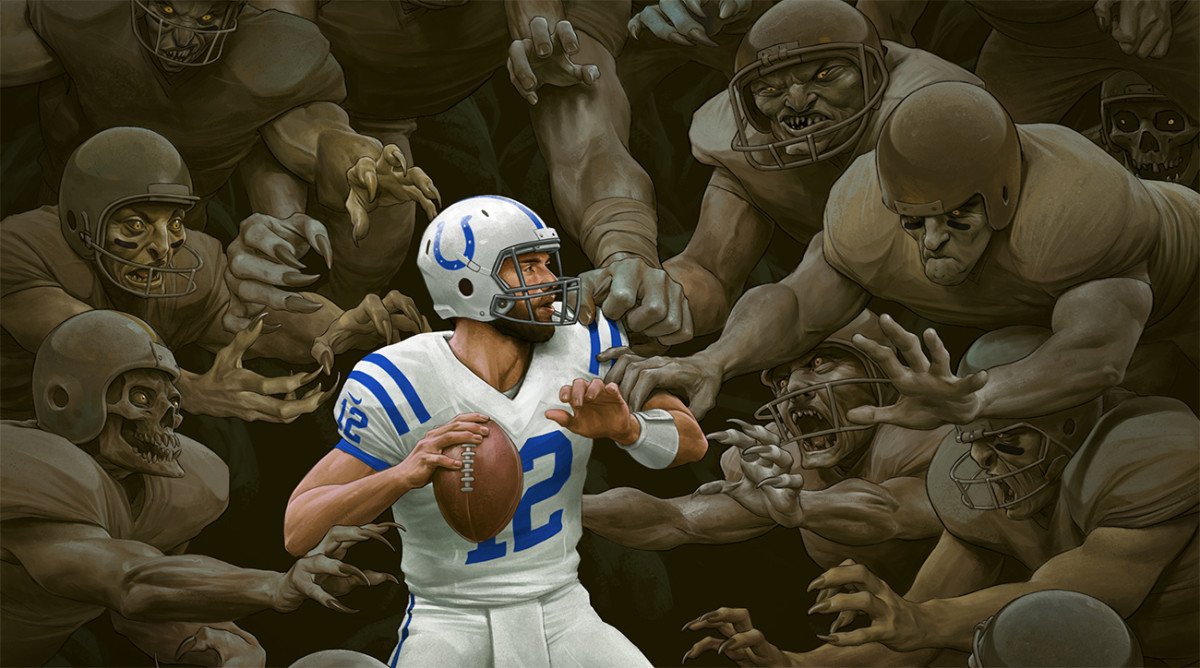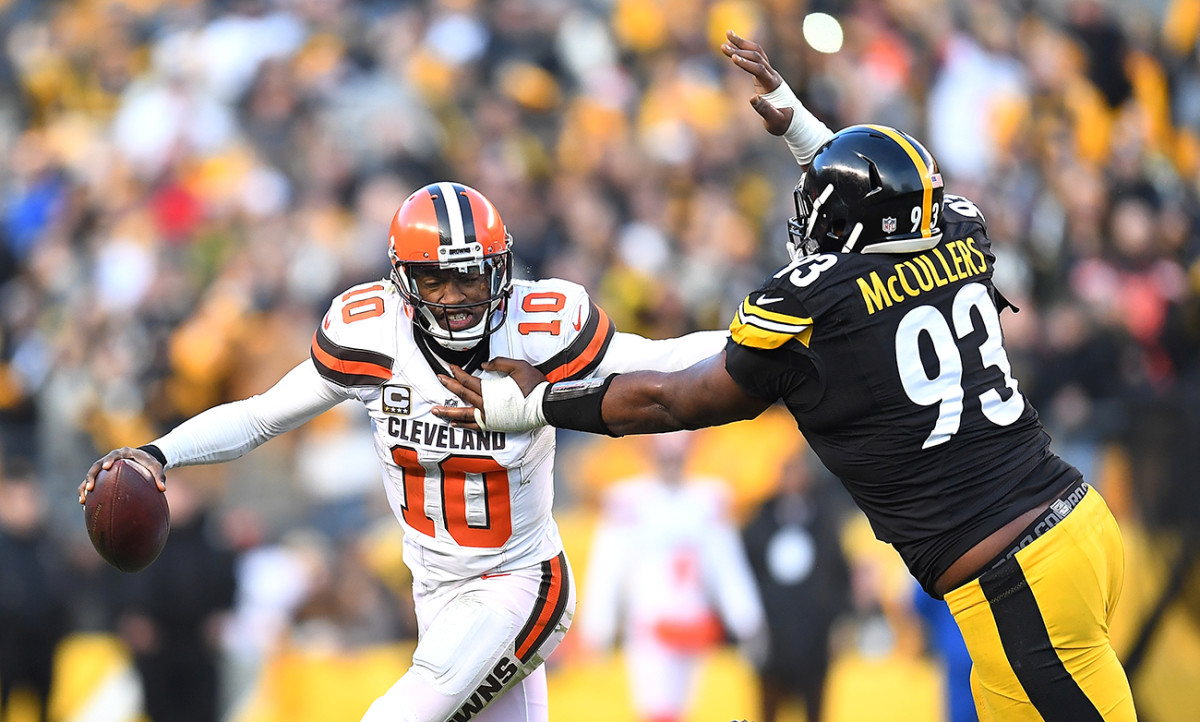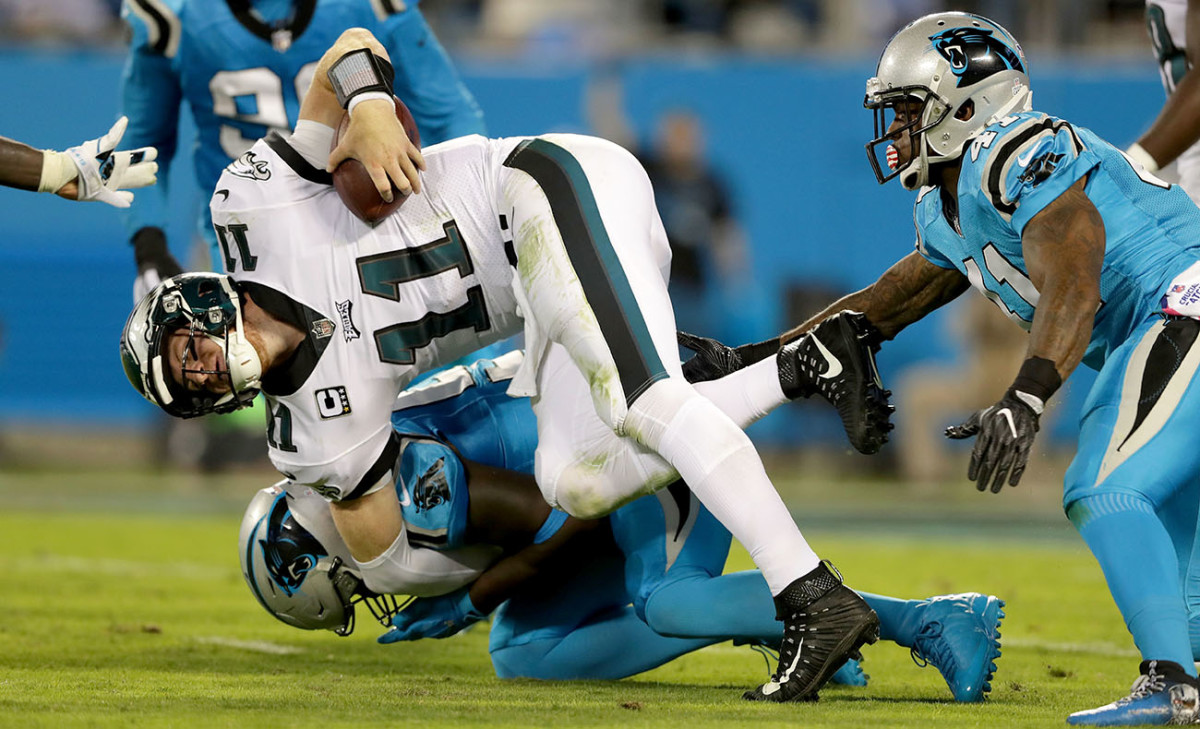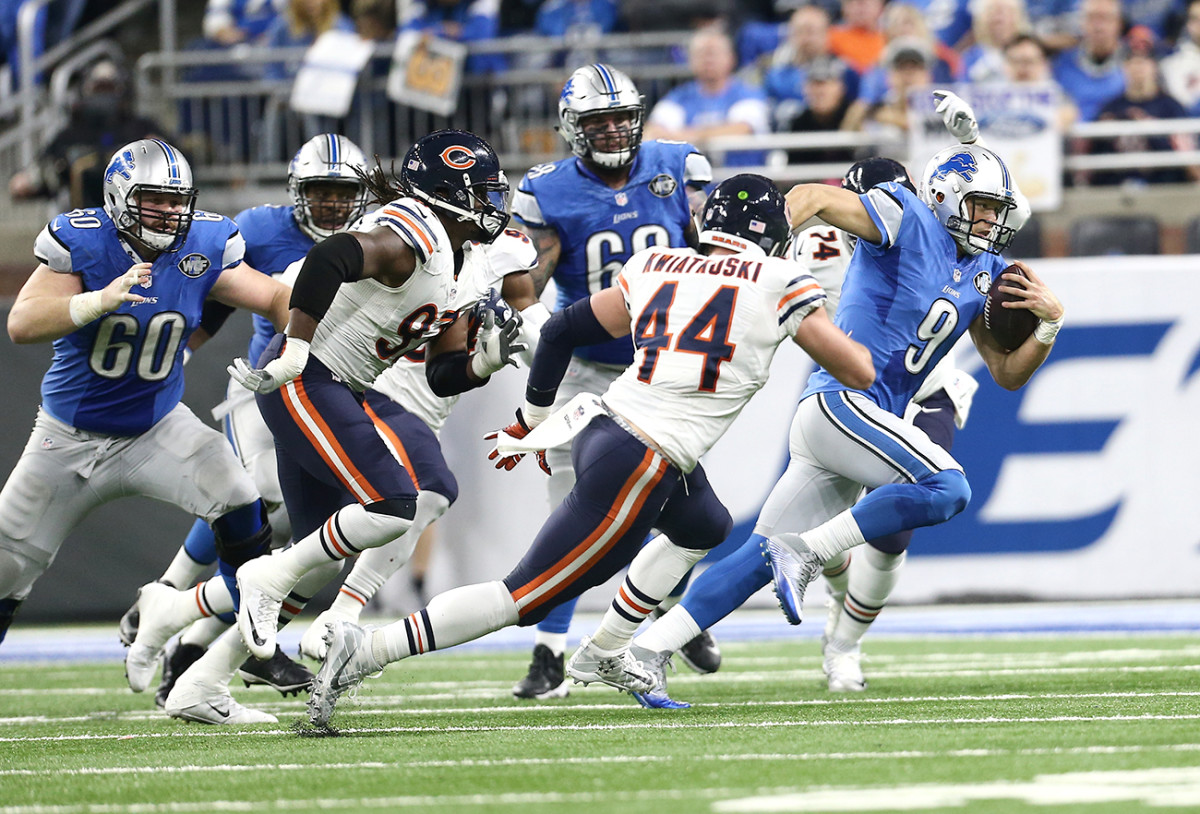‘Scrap the Superman Cape’: Advice for Avoiding Injuries as an NFL QB

This story appears in the Aug. 27, 2018, issue of Sports Illustrated. For more great storytelling and in-depth analysis, subscribe to the magazine—and get up to 94% off the cover price. Click here for more.
In Week 6 last year, facing an early second-and-nine in Minnesota, Aaron Rodgers took a quick three-step drop and spied no open receiver, so, as he had many—so, so many—times before, he fled the pocket. Scrambling right, the Packers’ QB rescanned the field, threw to Martellus Bennett and was immediately driven into the ground by Vikings linebacker Anthony Barr. On impact, Rodgers’s right collarbone fractured, shattering with it Green Bay’s Super Bowl chances. That injury—plus the shoulder problems that sidelined Andrew Luck for all of 2017 . . . plus the freak ACL tears that shelved young stars Carson Wentz and Deshaun Watson . . . plus a long history of promising campaigns quashed by injuries to adventurous passers—provokes a complicated question: What goes into keeping an aggressive QB safe? The answer is, well, complicated.

T.J. Lang, guard, Detroit Lions: Linemen, we tend to be grumpy. When there’s a clean pocket and a QB breaks out just to try to get a couple extra seconds, we’re like, “Just stay in the pocket, man!” But you really only get upset when the play results in a sack.
Ken Whisenhunt, offensive coordinator, Los Angeles Chargers: Outside the pocket, in space, with the speed of defenders out there—taking a hit is obviously something that puts you at risk of being injured.
Randy Fichtner, offensive coordinator, Pittsburgh Steelers: With a sack, we can figure out a way to overcome that. We can’t overcome a turnover. And we can’t overcome our quarterback getting hurt.
Hue Jackson, head coach, Cleveland Browns: Your starter, he’s like gold. You don’t want that guy touched. It changes the dynamic of everything for your team.
JC Tretter, center, Cleveland Browns: In Green Bay [where Tretter played from 2013 to ’16], as linemen we had an Aaron Rodgers Rule: hold your blocks forever. There will be times where it’s like, “Hey, this is a three-step drop-back [and the play is still going on]?” I just blocked for as long as I could. I never thought, “Well, the ball should be gone.” There were times Aaron would come in the huddle and say, “Hey, right-side O-line: Make sure you get beat inside on this play—I’m rolling out right.” That was a unique way to start my career, the way he would backyard football it. You’re like, That’s not a great look for me. . . . Then he rolls out and hits a crosser in the middle of the field, wide open. It’s fun to play with him that way.
Bruce Arians, retired coach: A quarterback faces that moment of truth: Can I really make a play out of this? Uhhh, no—get rid of it! Either get out of bounds or throw it away. But don’t take a hit.
Fichtner: Get rid of the ball. I can’t remember the last time Ben Roethlisberger [left the pocket and] lost a single yard taking a sack. He’s gonna throw the ball away. That’s being aware.
Arians: Early on [when Arians was Pittsburgh’s offensive coordinator] he was “Big Ben.” He had the Superman cape on, and he wasn’t ever going to throw it away. He’ll get rid of it quicker now because of his experience. It took a couple of ankle injuries for him to stop holding on to it so long. . . . But there’s a fine line. You don’t ever want him to totally give up that Superman cape. That’s what makes him special. He was so different from Peyton Manning. Peyton had a clock in his head: 1, 2, 3—this ball’s going somewhere. He couldn’t run, so he knew he was going to throw. But Ben could knock guys down. He’d pump-fake them and make plays. Andrew Luck’s the same.
Andrew Luck, quarterback, Indianapolis Colts: I’d like to think I can continue to extend plays [coming off an 18‑month shoulder injury], but I think it’d be foolish of me to not adjust certain things about running.
Frank Reich, head coach, Indianapolis Colts: Luck can absolutely still extend plays. . . . He has elite athletic ability for the position, and his ability to extend within the pocket, that’s a big part of it.
Arians: Andrew threw an interception [in 2012, when Arians coached the Colts], and then he went down and laid out the guy who intercepted it. And I told him, “We never tackle with our [throwing] shoulder.” He said, “I throw the interception, I make the tackle.” And I said, “No, you don’t. Just get down. If you’re the last line of defense, grab him by the face mask. I don’t care.”
Matthew Stafford, quarterback, Detroit Lions: There’s a time and a place for extending plays. When there’s a guy [opening up] down the field and you have a chance to make a big play? Hold on to the ball a little bit longer. It’s all in the context of the game. I’m not perfect at it. I’ve had my fair share of dings.
Arians: Sometimes you use your bravado as a young player to win over your locker room, show them you’re tough. I think of Carson Wentz right away. Luck. You do some things in your first few years you probably wouldn’t do in your fourth and fifth, when you have the respect of your locker room and don’t have to prove to your teammates that you’re tough anymore.
Reich: I certainly saw that with Carson [in Philly, where Reich coached the offense the last two seasons]. Especially his rookie year. A lot of these quarterbacks came from college offenses where they were runners as well—all of that spread-option stuff. They’re fearless. You just can’t do that in this league.
Bill Lazor, offensive coordinator, Cincinnati Bengals: As much as people talk about ideas from college slipping into the pros, I think these hits on the quarterback create a ceiling in the NFL for some of the college schemes. There are a handful of quarterbacks who you don’t mind taking the hits. True runners. But for the majority of them, it’s not worth it.
Reich: You show your young QB the film; you show him guys doing it the right way. And then you show him what happens when you don’t do it the right way. You don’t want them to be scared, but players in this league are faster and stronger. Extend plays enough times, you’re going to get hurt. They just have to buy into that. Carson, he didn’t buy into it right away. I am who I am. . . . I can’t promise you. That kind of stuff. But as time goes on, he realized he has a responsibility to the team. I think [Luck] understands that now.
Luck: It’s situational. It’s about understanding—and I do feel I’ve gotten better at this—that there’s a difference between middle of the first quarter, second-and-eight, and fourth quarter, third-and-five.
Lazor: When these situations come up early in the game you have to think to yourself: There are going to be 65, maybe 70 more plays in this game.
Stafford: It’s tough because at a certain point I want to prove myself to everybody in that locker room. I’ll sacrifice for anybody in there. I still do that crap all the time. The first game of last year, Arizona, third down, long run—I got friggin’ blasted. Coaches don’t want to see it that much, but the guys appreciate it. There’s a time and a place where you’ve got to do it.
Eli Manning, quarterback, New York Giants: There are a few times where it kind of pops in your head: Hey, maybe I can make this guy miss. In big games, you’ve got to make a guy miss, you’ve got to get first downs. But the hits aren’t worth it. So a lot of it is sliding as a runner.
Whisenhunt: It’s amazing, some of the guys who don’t know how to slide. You’d think I could just tell you, “Hey, slide,” and you’d be able to do it. But there have been guys we have had to work with on that.
Andy Dalton, quarterback, Cincinnati Bengals: My first slide ever was pretty bad—I got caught between diving and sliding. Now, for the most part, I just slide. It’s all about understanding when to slide. You don’t want to slide late. Look at my first slide ever, in a preseason game, and where I’m at now. It’s night and day.

Perhaps no active player has been at the center of these discussions more than Robert Griffin III, who stormed onto the scene as a dual-threat rookie for Washington in 2012 but who has played in only five games since ’15 due in part to injuries and his dependence on running. The last time Griffin entered a season as a starter, for Jackson’s ’16 Browns, he fractured his shoulder on a hit against the Eagles in Week 1. On that play Griffin scrambled immediately upon hitting the top of his drop-back, before his receivers’ routes could unfold.
Jackson: You want a guy to understand: We’re really trying to get you to throw, as opposed to run. He’s a passer first. In that play [where Griffin was injured] we were losing; we were trying to make some plays downfield to come back. So you drop back and get a chance to escape—but you still must do everything you can to protect yourself.
Robert Griffin III, quarterback, Baltimore Ravens: If you’re surrounded by four or five guys, get down and protect yourself. But when you have a one-on-one, if you feel like you can make the guy miss, go ahead and try to make him miss. I’ve done it where I’ve tried to just run through everybody, and that didn’t work out. I’ve tried to just get down all the time, and that didn’t work out. . . . The play I got hurt on, in Philly, I was running out of bounds. So I don’t know what else I was supposed to do.
Fichtner: This is the thing that separates Ben [Roethlisberger]. I know guys who can extend plays. But Ben extends to throw the football. A lot of guys extend to potentially throw, but they aren’t capable of being accurate when that time comes.
Arians: The safest thing for a quarterback is knowing what the hell you’re doing.
Sean McVay, head coach, Los Angeles Rams: If you know the play and its intent—if you understand and own the play’s mechanics—then you can solve the potential problems that can arise based on what a defense presents. You have a good chance of keeping yourself out of harm’s way.

A perfect illustration of this: Giants tight end Evan Engram’s 35-yard catch in Week 14 last season against Dallas. The Cowboys had called a disguised fire zone blitz on first-and-10 near midfield, an extremely uncommon tactic in that situation. Manning audibled Engram to a corner route.
Manning: We were supposed to get the running back to protect, but he didn’t go over there. We’d checked the play knowing they were going to come with that blitz. Earlier in my career I wouldn’t have seen the blitz, and I definitely wouldn’t have had the nerve to suggest to our coaches beforehand, “We should put this play in, I think it will work against this blitz.” I had a feeling Evan was going to be open. So I dropped back and threw it, and I kind of ducked a tackle [from the slot blitzer] so I didn’t take a hit in the face.
That sense for throwing and then contorting his body to better absorb a hit is a big reason the Giants’ quarterback has never missed a game due to injury.
Manning: You just throw it and kind of continue to turn, so the defender gets a hit on your backside rather than right in the face or the chest. You’re also falling away a little, so it’s not as big of a hit—you’re kind of going with the hit. That’s instinct. It’s not something I work on or practice.
Dalton: When someone is grabbing on to you, don’t just stand there, try to get down. If you feel like you can get out of it, try. My first preseason game, Ndamukong Suh knocked my helmet off, slammed me down to the ground, got a 15-yard penalty and got fined a lot of money—all that stuff. That was kind of like, O.K., I’ve got to find a way to not let this happen.
Whisenhunt: The No. 1 thing for a QB’s safety is protecting himself in the pocket.
McVay: It’s having a good feel for how to manipulate the way a rush lane plays out. To extend plays, everybody automatically thinks of Aaron Rodgers and Russell Wilson. But Tom Brady’s as good as anyone because he knows how to slide within the pocket and buy time within the framework of the pass rush.
Fichtner: One of the things you can do as a quarterback is manipulate guys downfield [with your body language and mechanics]. Move the pocket. Feel, step, slide, reset, get to the right spot in time and get the ball out.
Stafford: You try to find the safe spots. There should be a little dent in the pocket where you can hang out. The rest of it is very instinctual. You’ve got people at your feet. I feel like my feet come off the ground just as [I get hit]. I don’t practice that ever. It’s just instinct.
Whisenhunt: Two things you work on are stepping up in the pocket and making sure you have consistent depth in the pocket, so your O-line knows where you are. For instance, if [the line is] setting the pocket at 9 1/2 yards and the quarterback takes a seven-step drop and he’s at 11 yards, he’s going to get hit by the guy coming around the edge.
Stafford: Pocket movement is not learned off a piece of paper. It’s learned by doing drills and by playing in games. And everybody does it differently. Philip Rivers does it differently than Carson Wentz. Aaron Rodgers does it differently than Tom Brady.
Tretter: Aaron’s going to step up, step out and step back up in a way that makes the defensive end rush back inside. He allows you to pin the defensive end inside.
Jackson: It’s really all about the protection. You must make sure their best rusher doesn’t get to your guy. That’s the goal at the end of the day, that you’re able to stop the Von Millers or the Terrell Suggses of the world.
Lazor: The hardest thing to do in the NFL is to build a passing game. The thing that comes along the slowest is the pass protection. The flip side: That’s arguably the most important thing you do because it keeps your quarterback healthy.
Reich: This all starts with A-gaps [between the center and guard]. That’s the shortest route to the quarterback. You start there and work your way out. You don’t want anyone in the quarterback’s face.
Whisenhunt: The quarterback and center—those are the most important for the protection. That and everybody being on the same page. When you’re not on the same page and a defender comes free, that’s where the greatest risk of injury is.
Tretter: [In Green Bay] Aaron and I would meet at some point every week—maybe you grab the guy during breakfast or something—and make sure we’re on the same page on how we’re going to pick up every blitz. If we’re in, say, a five-man protection and the defense is bringing six, Aaron knows which defender we’re going to turn loose.
Whisenhunt: The second tier of quarterback safety is the receivers. Some teams try to protect everything, but others try to put it on the receiver and the quarterback to throw a hot route or sight adjust. A sight adjustment is essentially a hot route, but for outside receivers.
Stafford: The guys on the outside have to win their routes at the right depth and at the right timing—that’s what goes into a productive passing game: We’re getting the ball out, quarterback’s getting hit as little as possible, and we’re still able to push the ball down the field.
Reich: Especially early in the game, it’s very important to get the ball out quick. Let the defense know that it’s going to be a long day. Let them think: We can’t get to him; they’ve got all this quick rhythm-type stuff. They start to panic a little, get discouraged. They lose a bit of their edge.

The theories for how to keep quarterbacks safe are boundless. They also come with an uncomfortable understanding that these things are not entirely in the user’s hands. And it’s not so much about avoiding injuries all together as it is about avoiding certain types of injuries.
Manning: It’s survival, trying to understand that over 16 weeks, you’re going to take hits.
Whisenhunt: Hits to the knees and hits to the heads—you don’t have control over how that’s going to go.
Stafford: There’s a little luck in it all. I can play with a sprained ankle. But I can’t play with a separated shoulder.
• Question or comment? Email us at talkback@themmqb.com.
